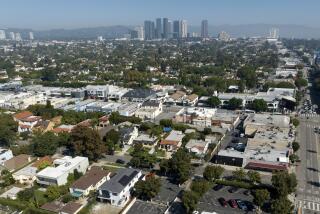Development May Impact Roads, Oaks, Water, Study Says
- Share via
MOORPARK — A massive housing development planned northeast of Moorpark could clog traffic, sap local water supplies and take out more than 1,700 old oak trees when it is finally built, according to an environmental impact report released Tuesday.
The 3,221-home development proposed by Messenger Investment Co. of Irvine, larger than the Ahmanson mini-city planned near Simi Valley, could add at least 10,000 people to Moorpark’s population, about a 36% increase.
The Messenger project is one of four proposed housing developments that have the potential to again make Moorpark one of the fastest-growing cities in Ventura County over the next decade.
Although the 2,000-page report indicates that traffic congestion, water supply and the loss of natural habitat may be significant, city planners and the developer believe that most of the adverse impact can be avoided.
The project, planned for about 4,300 acres of scrub brush and oak-covered ranchland, is expected to cost well over $1 billion and take more than 12 years to build, company officials said.
As proposed, nearly half of the acreage would be dedicated as permanent open space and incorporated into the nearby Happy Camp Canyon Regional Park, which is managed by the Santa Monica Mountains Conservancy.
Since the environmental study began more than a year ago, city leaders have expressed concern about the increased traffic that the project would bring to the city.
According to the environmental impact report, the development could generate more than 20,000 car trips every day by the year 2000 and up to 47,000 trips per day by the time the project would be completed in the year 2010.
Despite the huge increase in traffic, engineers estimate that if the city follows through with planned road improvements, traffic from the new development will not pose a problem.
The most important road improvement, said Richard Pool, a traffic engineer who conducted the study, is to build a major east-west artery in the city.
For many years, the California Department of Transportation has anticipated extending the Simi Valley Freeway from its interchange with the Moorpark Freeway through the north side of Moorpark to connect with Los Angeles Avenue near Gabbert Road on the west side of town.
But plans to build that route could be more than 40 years away, Caltrans officials said.
As an alternative, the city could build a roadway that parallels the proposed extension, Pool said.
That road would cross another proposed development, and connect the Messenger project and the other development with the city’s downtown.
The lack of an east-west route leaves residents on the east side of town isolated from the city’s downtown, so many shop in Simi Valley.
A recent economic study shows that three out of every four dollars spent by local residents are spent out of town, said Gary Austin, a vice president at Messenger Investment.
Improving the connection between the two sides of town would stop some of the capital flight.
“It’s our opinion that a cross-town connection . . . would funnel people into town, which has to be good for downtown businesses,” Austin said.
Drivers in and out of the Messenger development would use Campus Park Drive on the east side of Moorpark College and another route that would connect with Broadway via another, yet-to-be-built road through Happy Camp Canyon Regional Park.
Traffic engineers said those routes could easily handle the increased traffic.
As for the other major effects of the development, Austin said the company already has plans to address them.
Although the housing development is expected to need almost 2 million gallons of water every day, Austin said the company plans to use reclaimed waste water to irrigate a planned 18-hole golf course and the half a dozen parks--significantly reducing the need to import more water.
Another major impact, according to the report, is the project’s effect on more than 1,700 oak trees. Company officials insist that they have no plans to remove all or even a majority of the trees.
“We were shocked when we saw that number,” Austin said.
By grouping the planned homes in small village-like clusters, separated by bands of undeveloped land, Austin said the company would be able to avoid removing some trees from the property and could also avoid building in environmentally sensitive areas.
“They used a worst-case scenario,” he said. “We fully intend to avoid harming any mature oak groves.”
A public hearing on the project is scheduled Oct. 9 before the Moorpark Planning Commission. Other public meetings will be scheduled to go over the environmental impact report after that date, city planners said. The report may be viewed at Moorpark City Hall, 799 Moorpark Ave.
More to Read
Sign up for Essential California
The most important California stories and recommendations in your inbox every morning.
You may occasionally receive promotional content from the Los Angeles Times.













